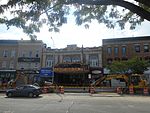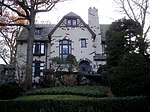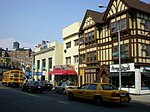Richmond Hill station (LIRR)

Richmond Hill is a closed station on the Montauk Branch of the Long Island Rail Road in the Richmond Hill neighborhood of Queens in New York City. The station is located at Myrtle Avenue and cuts diagonally from the intersection of Jamaica Avenue and Lefferts Boulevard through to Hillside Avenue. The station has two tracks and an island platform. Richmond Hill was the only station on the Lower Montauk Branch that was elevated with a high-level platform for passengers to wait for trains; the others were at ground level, with low-level platforms. Richmond Hill station was originally built by the South Side Railroad of Long Island in 1869 as Clarenceville station. After New York City and the Long Island Rail Road began negotiating the elimination of numerous at-grade crossings within Queens in the 1910s, the current station was opened on a viaduct in 1923. The station was closed on March 16, 1998, along with nine others due to low ridership and the potential cost of upgrading the stations to modern standards; at the time of its closure, the station had one passenger per day.
Excerpt from the Wikipedia article Richmond Hill station (LIRR) (License: CC BY-SA 3.0, Authors, Images).Richmond Hill station (LIRR)
Hillside Avenue, New York Queens
Geographical coordinates (GPS) Address Nearby Places Show on map
Geographical coordinates (GPS)
| Latitude | Longitude |
|---|---|
| N 40.700555555556 ° | E -73.832222222222 ° |
Address
Hillside Avenue 117-10
11418 New York, Queens
New York, United States
Open on Google Maps









